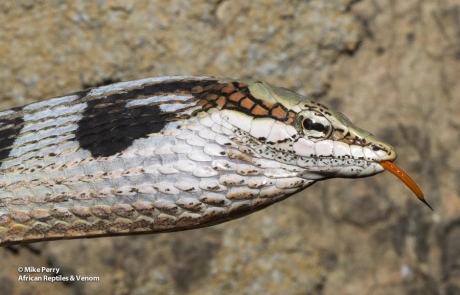Vine or Twig Snake
VERY DANGEROUS
Very slender with long, thin tail. Adults 1 200 mm long. Head elongate, narrow, flattened above and distinct from neck. Dark line extends between eye and mouth. Eye large, round; pupil horizontal and keyhole-or dumb-bell-shaped when not fully dilated; iris pale, grey to creamy or green. Top of head green with black, or black and brown spots. Colour above various shades of grey, resembling a twig or vine, with lighter banding towards the rear. Paler below. Tongue bright-yellow, to orange, vermillion or scarlet, with black tip. Feebly-keeled dorsal scales in 19 rows at mid-body; anal divided.
Enlarged, grooved fangs situated posteriorly on maxillary bone.

Potent, potentially lethal, pro-coagulant haemotoxin causing skin, mucosal and internal bleeding. Treatment limited to replacement of blood products and careful supportive management, including haemodialysis in some patients. Famous herpetologist, Robert Mertens, died after receiving a bite. No anti-venom is available.
Coastal forest, savanna and bushveld. Prefers low bush or thickets.
Diurnal, arboreal, active hunter. Well-camouflaged, escaping detection by remaining motionless. Horizontal pupil enables keen, unimpeded binocular vision. Prey on geckoes, chameleons, frogs, toads and small snakes. Well-known for raiding birds’ nests for hatchlings; often relentlessly mobbed by parents, and occasionally killed by birds. Inoffensive, not often implicated in snakebites. When annoyed, inflates front part of body similarly to Boomslang. Strikes sideways towards an intruder. Relies on biting and chewing to deliver venom to tissues, and should never be afforded an opportunity to do so.
Reproduces by egg-laying.






